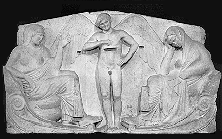|
"A very clever sculpture from the end of the 19th Century." F. Baroni, 1961. "The date (of the Boston Throne) is controversial...the late 5th Century BC is nevertheless the most probable." H. Prueckner, 1968.
"If it is in some ways odd for the fifth Century, it is still too good... to convince as a piece of 5th Century BC art imagined by a late Victorian." |
 |
Whilst the Ludovisi Throne has been linked convincingly to Greek Art in general, and specifically Locri in South Italy, the origin of the Boston Throne, left, is questionable.
Many critics have stressed an opinion on the function and origin of the Boston Throne. It should be noted that until 1996 the Thrones had never been seen side by side. Most critics have therefore judged the Boston Throne |
|
The main theories regarding the origin of the Boston Throne are:
It has been suggested that 12th Century Metopes on the Cathedral at Modena are very similar to the Thrones, and that this would indicate that they were above ground at this point. Although not impossible, this is a very subjective viewpoint.
Both the Ludovisi Throne and the Boston Throne have similar damage and it has been suggested that they must have been together when this was carried out. All of the above theories are possible, and none have ever been completely discounted. |